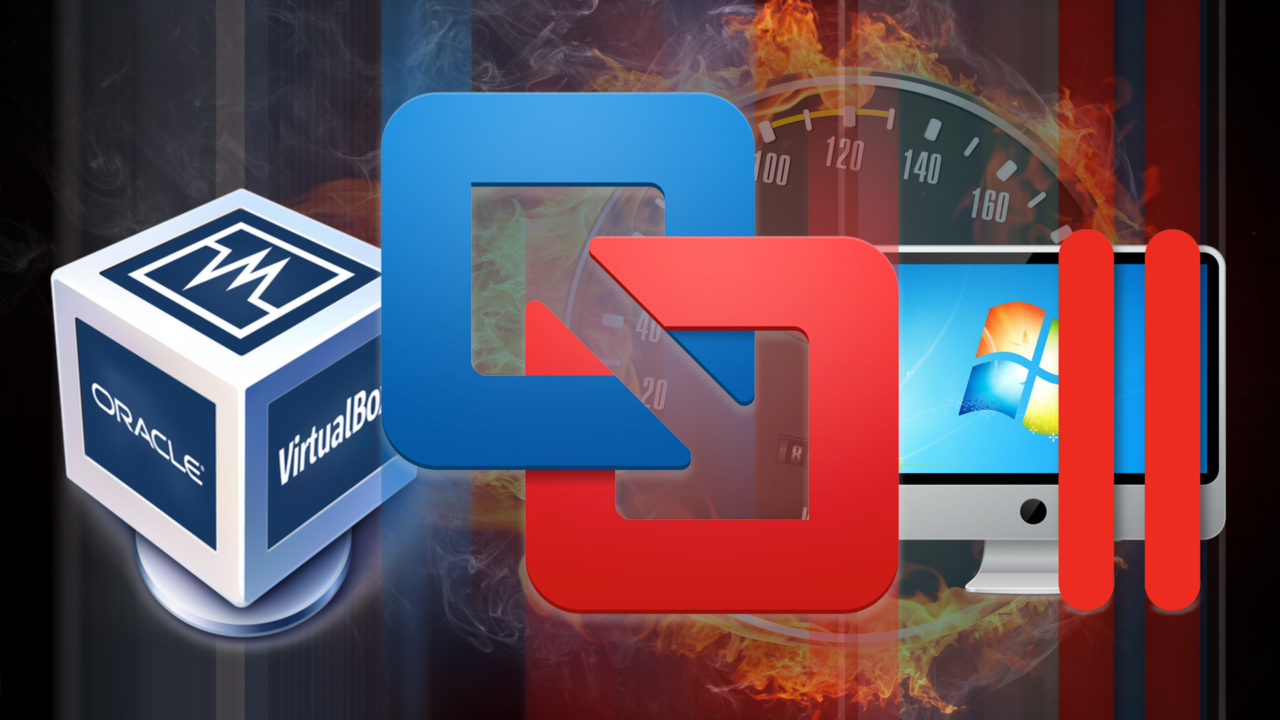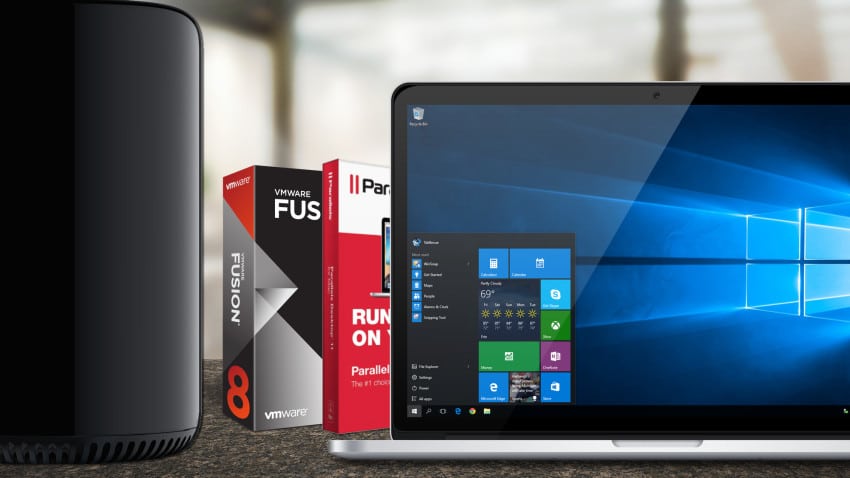2015 VM Benchmarks: Parallels 11 vs. Fusion 8 vs. VirtualBox 5

Test Setup & Methodology
As mentioned in the introduction, we ran our Parallels 11 vs. Fusion 8 benchmarks on two hardware platforms: a MacBook Pro and a Mac Pro. The MacBook Pro is a Mid-2014 15-inch model, with a 2.5GHz Intel Core i7-4870HQ, 16GB of RAM, 2GB NVIDIA GeForce GT 750M, and 512GB PCIe flash storage. The Mac Pro is a Late 2013 model with a 6-core Intel Xeon E5-1650 v2, 64GB of RAM, dual 3GB AMD D500 GPUs, and 256GB PCIe flash storage. The MacBook Pro was our primary test platform, used for all results unless otherwise noted.
Our host operating system for all virtualized tests was OS X Yosemite 10.10.5, the latest publicly available version as of the date of this article. Even though both Fusion 8 and Parallels 11 support OS X El Capitan, we’re reluctant to perform tests on beta software where bugs or future changes could play a factor in skewing the results. We’ll revisit El Capitan once it launches later this year and we’ll let you know if it provides any performance boosts that would alter the benchmark results reported here.
Our guest operating system for all tests was Windows 10 Pro 64-bit, which was installed separately in four configurations: native to the Mac’s hardware via Boot Camp, in a virtual machine powered by Parallels 11, in a virtual machine powered by Fusion 8, and in a virtual machine powered by VirtualBox 5.
Regarding our decision to use the 64-bit version of Windows, it’s true that the 32-bit version can be easier to virtualize and therefore may offer slightly better performance in certain circumstances. Unfortunately, the latest version of Boot Camp requires the use of a 64-bit version of Windows, so we were forced to use 64-bit VMs as well in order to maintain consistency between the platforms.
As for our virtualization software, we used the latest available version of all applications, which at the time of publication is Fusion 8.0.0, Parallels 11.0.0, and VirtualBox 5.0.3, which is admittedly a test build but is required to provide Windows 10 compatibility.
Each of our Parallels and Fusion Windows 10 virtual machines was configured for maximum performance, with 8 assigned virtual CPUs, 12GB of RAM (the maximum recommended amount in order to ensure that enough is reserved for OS X), and 1GB of graphics memory configured for each platform’s most advanced DirectX and OpenGL graphics support. The VirtualBox VM was also configured to its maximum supported hardware level, with matching CPU and RAM, but with only 256MB of graphics memory, the most it allows. For all platforms, all features that could possibly impact performance, such as error logging or an expanding virtual disk, were disabled.
All operating systems and testing software were updated to their most recent versions as of the date of this article. More information about each benchmark application or test can be found on its respective results page.
As is standard practice here at TekRevue, all tests, unless otherwise noted in the results, were performed three times for each Windows installation, and the results were averaged. Our normal procedure in the event of a discrepancy greater than 5 percent is to re-run the tests until the issue can be identified. The only test that required this additional analysis was battery life, and the issue is described further in that section.
Table of Contents
[one_half padding=”0 5px 20px 0″]
1. Introduction
2. Test Setup & Methodology
3. Geekbench
4. 3DMark
5. FurMark OpenGL
6. Cinebench R15
7. PCMark 8
8. Passmark PerformanceTest
[/one_half]
[one_half_last padding=”0 0px 20px 5px”]
9. Video Encoding
10. File Transfers
11. USB 3.0 Speed
12. Virtual Machine Management
13. Battery Life
14. Mac Pro: Gaming
15. Mac Pro: CPU
16. Conclusions
[/one_half_last]


















28 thoughts on “2015 VM Benchmarks: Parallels 11 vs. Fusion 8 vs. VirtualBox 5”
* ESXi with macOS guest
Has anyone else notices that Fusion runs a bit “hotter” than Parallels? I find that opening up Fusion to Win 7 or Win 10 automatically gets the temp up at least 20 degrees (F) or so on my rMBP (2015) set for 2 of 4 cores and 8 of 16 gigs of the RAM allocated. This is very disappointing. I have zero issue with the VMware offering (used it years ago) save for this need to use more energy than Parallels. I only use Windows for a couple of apps but I would be worried about adding a more CPU intensive app if heat is generated like this at a greater scale.
Any thoughts or confirmation of Fusion running hotter?
On my current setup it seems to take an eternity for the memory on my Windows VM to be filled with all the data it needs (I need to have a SQL server and a related application running on my Windows OS). Are there any good metrics on how long it takes for the OS to load up files from the drive into memory?
PS: Hard drive is a traditional drive, system report describes as APPLE HDD ST1000DM003
1) The exact models and specifications for the testing hardware are listed in the article, along with the methodology used for the tests. You’ll find this information on the ironically named “Test Setup & Methodology” page.
2) We submitted our results and methodology to both Parallels and VMware to give each company a chance to respond. Neither company claimed that our testing procedure or the configuration of our virtual machines were incorrect or unfair.
3) Other than providing licenses for both Fusion 8 and Parallels Desktop 11 for our tests, TekRevue was not remunerated by either company in any way, nor were the tests conducted or guided by anyone outside of TekRevue.
4) These products, and our review, are primarily targeted at consumers. That’s why we used both a MacBook Pro and mid-level Mac Pro in the tests. If you’d like us to conduct future tests on your custom Mac Pro (I say “custom” because the Mac Pro you describe in your other comment — 2 x 6-core hyperthreaded 3.33GHz — is not a configuration Apple ever shipped), then please send it to us and we’ll be happy to do the additional testing. In general, however, I hope you’ll agree that your specific configuration isn’t applicable to ~99% of users.
I didn’t try any hard-core games, as I don’t use the machine for that purpose. However, multiple version of Windows (XP, 7, 10) ran faster and smoother overall in Parallels for general use in my experience.
Having said that, I had some trouble with Parallels recognizing certain USB devices that Fusion did not have trouble with. Complained about it to Parallels, and they’ve recently pushed out a new release that addressed and fix those problems, so I appreciate their customer support.
Good article, thanks!
VM Capabilities
VM Capabilities
You are forgetting one major thing: Fusion and Parallels are designed to integrate Windows with OS X. VirtualBox is designed to virtualise an entire machine as if it were 100% separate, no integration at all.
It would be worth seeing how Parallels & Fusion (or even Virtualbox, but I assume it’ll look absolutely terrible as far as performance goes) similarly act under a multi-chip host environment to see how they negotiate allocations between multiple physical chips, as opposed to threads all being sent to the same chip.
I’m an enthusiast of fusion 8 and a user fro version 5. This last release is a great goal!
Overall content on Tekrevue is very solid. I enjoy reading OS X tips mostly.
Thanks guys!:)